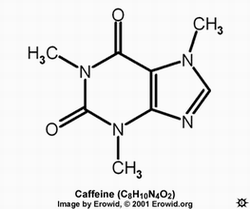apparently

there's no such thing as mateine...only the all-powerful and almighty caffeine! Damn I love the in-tar-web!
Hey Chemist - is this right?
It appears that several articles available online are completely bogus, having been either faked by a vendor to improve sales or a yerba mate fan in order to explain why they liked yerba maté tea and not other types of caffeinated tea. Almost all of the online discussions or mentions of mateine lead back to a single source, Daniel Mowry. Mowry provides no credible scientific references for his claims about mateine, mentioning only a couple of institutes who have reportedly done work with yerba mate. The only expert he cites, Dr. Jose Martin, when contacted by the author of an article about yerba mate, "said there is no unique chemical structure for mateine and that yerba mate contains caffeine, just like coffee".2
One of the errors in the literature upon which the "mateine" claims are based is the claim that mateine is a stereoisomer of caffeine. This stands out because, there are no stereoisomers of caffeine. In order to have a stereoisomer, a chemical nearly always (see below) must have a stereocenter. The caffeine molecule lacks a stereocenter, does not have one of the unusual special cases, and thus there are no stereoisomers. This error, repeated widely, has had no foundation in the scientific literature.
There is no stereoisomer of caffeine. It's that simple.

One thing to note is that people report slightly different effects from drinking yerba maté than from drinking green tea, although the exact differences have not been well documented. A common misunderstanding exists that this necessarily means that yerba maté does not contain caffeine as a major psychoactive alkaloid. Caffeine is a xanthine. Yerba maté contains two other xanthines (caffeine-like compounds) theobromine and theophylline that have their own effects. It is very possible for different experiential effects to be the result of different levels of these three compounds or of other variables, including differences in dosage, differences in accompanying minerals or related alkaloids, expectations, taste, smell, etc. Mint tea or gum, for instance, can be stimulating or refreshing partially based on smelling the volatile fragrance oil. It is not known exactly in what ways yerba maté is experientially different from Chinese teas or what accounts for those differences.
Labels: Caffeine or mateine, I feel robbed


